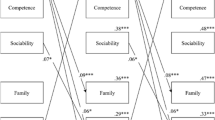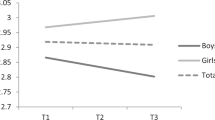Abstract
Moral disengagement processes are cognitive self-justification processes of transgressive actions that have been hypothesized to be learned and socialized within social contexts. The current study aimed at investigating socialization of moral disengagement by friends in two developmentally different age groups, namely late childhood (age: 9–10 years; n = 133, 42.9 % girls) and early adolescence (age: 11–14 years; n = 236, 40.6 % girls) over a 1-year period. Specifically, the current study examined whether similarity in moral disengagement between friends was the result of friends’ influence or friend selection. Moreover, gender (42 % girls), individual bullying behavior, and perceived popularity status were examined as potential moderators of socialization for moral disengagement within friendship networks. Self-report measures were used to assess moral disengagement, sociometric questions and a peer-nomination scale for friendship networks and bullying behavior, respectively. Longitudinal social network analysis (RSiena) was used to study change of moral disengagement in friendship networks during a 1-year interval. In early adolescence, friends were more likely to be similar to each other over time and this was explained only by influence processes and not by selection processes. Gender, bullying, and perceived popularity did not moderate the friends’ influence on moral disengagement over time. Results indicate that self-justification processes change over time already in late childhood, but only in early adolescence this change is likely to be dependent upon peers’ moral disengagement.
Similar content being viewed by others
References
Agnew, R. (2003). An integrated theory of the adolescent peak in offending. Youth & Society, 34(3), 263–299. doi:10.1177/0044118X02250094.
Bandura, A. (1986). Social foundations of thought and action: A social cognitive theory. Englewood Cliffs, NJ: Prentice Hall.
Bandura, A. (1990). Selective activation and disengagement of moral control. Journal of Social Issues, 46, 27–46. doi:10.1111/j.1540-4560.1990.tb00270.x.
Bandura, A. (1991). Social cognitive theory of moral thought and action. In W. M. Kurtines & G. L. Gewirtz (Eds.), Handbook of moral behavior and development: Theory, research and applications (Vol. 1, pp. 71–129). Hillsdale, NJ: Erlbaum.
Bandura, A. (2002). Selective moral disengagement in the exercise of moral agency. Journal of Moral Education, 312, 101–119. doi:10.1080/0305724022014322.
Camodeca, M., & Goossens, F. A. (2005). Aggression, social cognitions, anger and sadness in bullies and victims. Journal of Child Psychology and Psychiatry, 46(2), 186–197. doi:10.1111/j.1469-7610.2004.00347.x.
Caprara, G. V., Pastorelli, C., & Bandura, A. (1995). La misura del disimpegno morale in età evolutiva [Measuring age differences in moral disengagement]. Età Evolutiva, 51, 18–29.
Caravita, S. C. S., & Cillessen, A. H. N. (2012). Agentic or communal? Developmental differences in the associations among interpersonal goals, popularity, and bullying. Social Development, 2, 376–395. doi:10.1111/j.1467-9507.2011.00632.x.
Caravita, S. C. S., Gini, G., & Pozzoli, T. (2011). Moral disengagement for victimization in bullying: Individual or contextual processes? Oral communication at SRCD 2011 Biennal Meeting, Montréal (Quebec, Canada), March 31–April 2, 2011.
Caravita, S. C. S., Gini, G., & Pozzoli, T. (2012). Main and moderated effects of moral cognition and status on bullying and defending. Aggressive Behavior, 38, 456–468. doi:10.1002/ab.21447.
Caravita, S. C. S., Miragoli, S., & Di Blasio, P. (2009). Why should I behave in this way? Rule discrimination within the school context related to bullying. In L. R. Elling (Ed.), Social development (pp. 269–290). New York: Nova Science Publishers.
Cillessen, A. H. N. (2009). Sociometric methods. In K. H. Rubin, W. M. Bukowski, & B. Laursen (Eds.), Handbook of peer interactions, relationships and groups (pp. 82–99). New York, NY: Guilford.
Cillessen, A. H. N., & Mayeux, L. (2004). From censure to reinforcement: Developmental changes in the association between aggression and social status. Child Development, 75, 147–163. doi:10.1111/j.1467-8624.2004.00660.x.
Cohen, J. M. (1977). Sources of peer group homogeneity. Sociology of Education, 50, 227–241.
Dijkstra, J. K., Cillessen, A. H. N., & Borch, C. (2012). Popularity and adolescent friendship networks: Selection and influence dynamics. Developmental Psychology. Advance online publication,. doi:10.1037/a0030098.
Dijkstra, J. K., Cillessen, A. H. N., Lindenberg, S., & Veenstra, R. (2010). Basking in reflected glory and its limits. Why adolescents hang out with popular peers. Journal of Research in Adolescence, 20, 942–958. doi:10.1111/j.1532-7795.2010.00671.x.
Dornbusch, S. M. (1987). Individual moral choices and social evaluations: A research odyssey. In E. J. Lawler & B. Markovsky (Eds.), Advances in group processes: Theory and research (Vol. 4, pp. 271–307). Greenwich, CT: JAI Press.
Espelage, D., Holt, M., & Henkel, R. (2003). Examination of peer-group contextual effects on aggression during early adolescence. Child Development, 74, 205–220. doi:10.1111/1467-8624.00531.
Garandeau, C. F., & Cillessen, A. H. N. (2006). From indirect aggression to invisible aggression: A conceptual view on bullying and peer group manipulation. Aggression and Violent Behavior, 11, 612–625. doi:10.1016/j.avb.2005.08.005.
Gasser, L., & Keller, M. (2009). Are the competent the morally good? Perspective taking and moral motivation of children involved in bullying. Social Development, 18, 798–816. doi:10.1111/j.1467-9507.2008.00516.x.
Gini, G. (2006). Social cognition and moral cognition in bullying: What’s wrong? Aggressive Behavior, 32, 528–539. doi:10.1002/ab.20153.
Huisman, M., & Steglich, C. E. G. (2008). Treatment of non-response in longitudinal network studies. Social Networks, 30, 297–308.
Hyde, L. W., Shaw, D. S., & Moilanen, K. L. (2010). Developmental precursors of moral disengagement and the role of moral disengagement in the development of antisocial behavior. Journal of Abnormal Child Psychology, 38, 197–209. doi:10.1007/s10802-009-9358-5.
Hymel, S., Rocke Henderson, N., & Bonanno, R. A. (2005). Moral disengagement: A framework for understanding bullying among adolescents. Journal of Social Sciences, 8, 1–11. Retrieved from: http://www.krepublishers.com/06-Special%20Volume-Journal/JSS-00-Special%20Volumes/JSS-SI-08-Peer-Vicit-Schools-Web/JSS-SI-08-01-001-011-Hymel-S/JSS-SI-08-01-001-011-Hymel-S-Text.pdf.
Hymel, S., Schonert-Reichl, K. A., Bonanno, R. A., Vaillancourt, T., & Rocke Henderson, N. (2010a). Bullying and morality. Understanding how good kids can behave badly. In S. R. Jimerson, S. M. Swearer, & D. L. Espelage (Eds.), Handbook of bullying in schools. An international perspective (pp. 101–118). New York: Routledge.
Juvonen, J., & Galvan, A. (2008). Peer influence in involuntary social groups: Lessons from research on bullying. In M. Prinstein & K. Dodge (Eds.), Peer influence processes among youth (pp. 225–244). New York: Guilford Press.
Kandel, D. B. (1978). Homophily, selection, and socialization in adolescent friendship pairs. American Journal of Sociology, 48, 427–436.
Kohlberg, L. (1984). Essays on moral development: Vol. 2. The psychology of moral development. San Francisco: Harper & Row.
Marsh, P., Allen, J. P., Ho, M., Porter, M., & McFarland, F. C. (2006). The changing nature of adolescent friendships—Longitudinal links with early adolescent ego development. Journal of Early Adolescence, 26(4), 414–431. doi:10.1177/0272431606291942.
Menesini, E., & Gini, G. (2000). Il bullismo come processo di gruppo: Adattamento e validazione del questionario “Ruoli dei partecipanti” alla popolazione italiana [Bullying as a group process: adaptation and validation of the Participant Role Questionnaire to the Italian population]. Età Evolutiva, 66, 18–32.
Menesini, E., Sanchez, V., Fonzi, A., Ortega, R., Costabile, A., & Lo Feudo, G. (2003). Moral emotions and bullying: A cross-national comparison of differences between bullies, victims and outsiders. Aggressive Behavior, 29, 515–530. doi:10.1111/1467-9507.00121.
Moffitt, T. E. (1993). Adolescence-limited and life-course-persistent antisocial behavior: A developmental taxonomy. Psychological Review, 100, 674–701.
Ojanen, T., Sijtsema, J. J., Hawley, P. H., & Little, T. D. (2010). Intrinsic and extrinsic motivation in early adolescents' friendship development: Friendship selection, influence, and prospective friendship quality. Journal of Adolescence, 33, 837–851. doi:10.1016/j.adolescence.2010.08.004.
Ojanen, T., Sijtsema, J. J., & Rambaran, J. A. (2013). Social goals and adolescent friendships: Social selection, deselection, and influence. Journal of Research on Adolescence. doi:10.1111/jora.12043.
Paciello, M., Fida, R., Tramontano, C., Lupinet, C., & Caprara, G. V. (2008). Stability and change of moral disengagement and its impact on aggression and violence in late adolescence. Child Development, 79, 1288–1309. doi:10.1111/j.1467-8624.2008.01189.x.
Parkhurst, J. T., & Hopmeyer, A. (1998). Sociometric popularity and peer-perceived popularity: Two distinct dimensions of peer status. Journal of Early Adolescence, 18, 125–144.
Piaget, J. (1932). The moral judgement of the child. London: Routledge & Kegan Paul.
Pozzoli, T., & Gini, G. (2012). Friend similarity in attitudes toward bullying and sense of responsibility to intervene. Social Influence. Early view online. doi:10.1080/15534510.2012.716372.
Pozzoli, T., Gini, G., & Vieno, A. (2012a). Individual and class moral disengagement in bullying among elementary school children. Aggressive Behavior, 38, 378–388. doi:10.1002/ab.21442.
Pozzoli, T., Gini, G., & Vieno, A. (2012b). The role of individual correlates and class norms in defending and passive bystanding behavior in bullying: A multilevel analysis. Child Development, 83, 1917–1931. doi:10.1111/j.1467-8624.2012.01831.x.
Prinstein, M. J., & Dodge, K. A. (2008). Understanding peer influence in children and adolescents. New York: Guilford.
Salmivalli, C. (2009). Bullying and the peer group: A review. Aggression and Violent Behavior, 15, 112–120. doi:10.1016/j.avb.2009.08.007.
Salmivalli, C., Lagerspetz, K., Björkqvist, K., Österman, K., & Kaukiainen, A. (1996). Bullying as a group process: Participant roles and their relations to social status within the group. Aggressive Behavior, 22, 1–15. doi:10.1002/(SICI)1098-2337(1996)22:1<1:AID-AB1>3.0.CO;2-T.
Schwartz, D., & Gorman, A. H. (2011). The high price of high status: Popularity as a mechanism of risk. In A. H. N. Cillessen, D. Schwartz, & L. Mayeux (Eds.), Popularity in the peer system (pp. 245–270). New York: Guilford.
Shulman, E. P., Cauffmann, E., Piquero, A. R., & Fagan, J. (2011). Moral disengagement among serious juvenile offenders: A longitudinal study of the relations between morally disengaged attitudes and offending. Developmental Psychology, 47, 1619–1632. doi:10.1037/a0025404.
Sijtsema, J. J., Veenstra, R., Lindenberg, S., & Salmivalli, C. (2009). Empirical test of bullies’ status goals: Assessing direct goals, aggression, and prestige. Aggressive Behavior, 35, 57–67. doi:10.1002/ab.20282.
Snijders, T. A. B., van de Bunt, G. G., & Steglich, C. E. G. (2010). Introduction to stochastic actor-based models for network dynamics. Social Networks, 32, 44–60. doi:10.1016/j.socnet.2009.02.004.
Veenstra, R., Dijkstra, J. K., Steglich, C., & Van Zalk, M. (2013). Network-behavior dynamics. Journal of Research on Adolescence (in press).
Acknowledgments
The authors are grateful to the students, teachers, and school administrators participating in this study, and to Mrs. Silvia Capraro for her help in collecting the data. Part of this study was presented at the 2012 Biennal Meeting of the Society for Research on Adolescence, Vancouver, Canada, March, 2012 and at the European Association for Research on Adolescence, Spetses, Greece, August 2012. This work was partially supported by grant D1-2006 from the Università Cattolica del Sacro Cuore to the first author.
Author Contributions
SC conceived of the study, participated in its design and coordination, collected the data, and drafted the manuscript; JS participated in the design, performed the statistical analysis, and drafted the manuscript; AR participated in the design of the study, performed the statistical analysis, and drafted the manuscript; GG participated in design of the study and data collection, and drafted the manuscript. All authors read and approved the final manuscript.
Author information
Authors and Affiliations
Corresponding author
Rights and permissions
About this article
Cite this article
Caravita, S.C.S., Sijtsema, J.J., Rambaran, J.A. et al. Peer Influences on Moral Disengagement in Late Childhood and Early Adolescence. J Youth Adolescence 43, 193–207 (2014). https://doi.org/10.1007/s10964-013-9953-1
Received:
Accepted:
Published:
Issue Date:
DOI: https://doi.org/10.1007/s10964-013-9953-1




